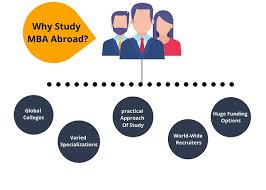Study MBA Abroad: Fees, Colleges, and Admission Process
Pursuing an MBA abroad has become an attractive option for students seeking to expand their knowledge, enhance their skills, and advance their careers on an international platform. An MBA from a reputed global business school not only equips students with advanced managerial expertise but also provides a unique opportunity to build global networks, experience diverse cultures, and increase their marketability in the global job market. However, the journey to studying an MBA abroad involves careful planning, a detailed understanding of fees, choosing the right colleges, and navigating the admission process. This guide explores all these aspects in detail.
Why Study MBA Abroad?
Studying for an MBA abroad offers numerous advantages, including:
- Global Exposure: Students gain insight into international business practices, cultures, and markets, preparing them for leadership roles in a globalized economy.
- Diverse Learning Environment: International MBA programs often attract students from various countries and industries, promoting collaboration, idea-sharing, and diverse perspectives.
- Enhanced Career Opportunities: Many top global MBA programs have strong ties with multinational corporations, offering students access to career opportunities that span the globe.
- High Return on Investment (ROI): Graduates from top international MBA programs often secure lucrative positions with competitive salaries, making the investment in education worthwhile.
Top Countries to Pursue MBA Abroad
While many countries offer MBA programs, some stand out due to the quality of education, global recognition of degrees, and the opportunities they offer post-graduation. Here are some top destinations:
- United States: Home to many of the world’s top-ranked MBA programs, such as those offered by Harvard Business School, Stanford Graduate School of Business, and Wharton, the U.S. is a leading choice for international MBA students.
- United Kingdom: The UK is known for prestigious schools like London Business School, Oxford’s Saïd Business School, and Cambridge Judge Business School. The UK is particularly popular for its one-year MBA programs.
- Canada: With schools like the University of Toronto’s Rotman School of Management and the University of British Columbia’s Sauder School of Business, Canada offers high-quality education with the added advantage of a more affordable cost of living and simpler immigration policies.
- Australia: MBA programs in Australia, such as those offered by Melbourne Business School and the Australian Graduate School of Management (AGSM), are increasingly becoming popular due to their strong curriculum and multicultural student body.
- Europe: Countries like France (INSEAD, HEC Paris), Spain (IESE, ESADE), and Switzerland (IMD) are renowned for their business education and offer great MBA programs with a European perspective.
MBA Fees Abroad
The cost of pursuing an MBA abroad varies depending on the country, institution, and program duration. Below is an overview of the average fees for MBA programs in different countries:
1. United States
- Range: $60,000 to $150,000 for the entire program.
- Examples: Harvard Business School ($146,880 for two years), Stanford Graduate School of Business ($140,680 for two years).
- Living Costs: Depending on the city, students can expect to spend around $20,000 to $30,000 per year on living expenses.
2. United Kingdom
- Range: £45,000 to £100,000 for the entire program.
- Examples: London Business School (£97,500 for 21 months), Oxford Saïd Business School (£65,520 for one year).
- Living Costs: London can be quite expensive, with living expenses reaching £15,000 to £25,000 per year.
3. Canada
- Range: CAD 50,000 to CAD 100,000 for the entire program.
- Examples: Rotman School of Management (CAD 131,120 for two years), Sauder School of Business (CAD 90,000 for 16 months).
- Living Costs: Approximately CAD 15,000 to CAD 20,000 per year.
4. Australia
- Range: AUD 60,000 to AUD 125,000 for the entire program.
- Examples: Melbourne Business School (AUD 99,000 for two years), AGSM (AUD 87,820 for one year).
- Living Costs: AUD 20,000 to AUD 30,000 per year, depending on the city.
5. Europe
- Range: €60,000 to €100,000 for the entire program.
- Examples: INSEAD (€89,000 for one year), HEC Paris (€82,000 for 16 months), IMD (€97,500 for one year).
- Living Costs: In European cities, students typically spend around €15,000 to €25,000 annually on living expenses.
While the fees may seem high, many institutions offer financial aid, scholarships, and loan options to make studying an MBA abroad more accessible.
Scholarships and Financial Aid
Most top MBA schools offer scholarships based on merit, need, or a combination of both. External organizations and governments also offer scholarships to international students. Some common types of scholarships include:
- Merit-based Scholarships: Offered to students with exceptional academic or professional achievements.
- Need-based Scholarships: Offered to students who demonstrate financial need.
- Country/Region-specific Scholarships: These are designed for students from specific countries or regions.
- Corporate Sponsorships: Some students receive sponsorship from their employer, particularly those in managerial or executive roles.
Examples of Popular MBA Scholarships:
- Fulbright Program (USA): For international students pursuing graduate studies in the U.S.
- Chevening Scholarships (UK): For students from developing countries studying in the UK.
- Rotary Foundation Global Grant: Available for graduate-level coursework in many countries.
- Forte Fellows Program: Targeted at women pursuing MBAs in the U.S. and Europe.
Process of Admission to MBA Abroad
The admission process for MBA programs abroad is comprehensive and competitive. Students need to be well-prepared to meet the academic, professional, and personal requirements set by the business schools. The following is a step-by-step guide to the admission process:
1. Research and Shortlisting Schools
- Begin by researching the best MBA programs that align with your career goals. Consider factors such as the school’s reputation, program duration, faculty, location, alumni network, and career services.
- Shortlist 4-5 schools that match your preferences and offer strong post-MBA career opportunities.
2. Eligibility Requirements
Most top MBA programs abroad require applicants to have:
- A bachelor’s degree from an accredited institution.
- Several years of work experience (typically 3-5 years for full-time MBA programs).
- Strong academic performance in undergraduate studies.
3. GMAT/GRE Scores
Most business schools require applicants to submit scores from either the Graduate Management Admission Test (GMAT) or the Graduate Record Examination (GRE). A high GMAT/GRE score enhances your application, although some schools have started offering GMAT waivers under specific conditions.
4. Language Proficiency Tests
For non-native English speakers, a language proficiency test like TOEFL or IELTS is often required. Ensure you meet the minimum required score set by the school.
5. Application Materials
Once you’ve identified your target schools, prepare the following application materials:
- Resume/CV: Highlight your work experience, achievements, and leadership roles.
- Statement of Purpose (SOP)/Essays: Provide insights into your career aspirations, motivation for pursuing an MBA, and why you are a good fit for the program.
- Letters of Recommendation: Typically, two or three letters from your professional supervisors or mentors are required.
- Transcripts: Submit your academic transcripts from previous institutions.
6. Interview Process
If shortlisted, candidates will be invited for an interview. Interviews are either conducted in person or online and focus on your leadership potential, career vision, and cultural fit within the program.
7. Application Deadlines
Most MBA programs have multiple rounds of admissions. It’s essential to keep track of deadlines to ensure you submit your application in the preferred round (typically Round 1 or Round 2 for the best chances).
8. Visa Process
Once accepted, the final step involves applying for a student visa to study in the respective country. The visa process can vary, so it’s advisable to start the process early after receiving your admission offer.
Tips for a Successful MBA Application
- Start Early: Begin your preparation at least a year before your intended enrollment date to give yourself enough time to prepare for tests, write essays, and gather all necessary documents.
- Leverage Your Work Experience: Focus on highlighting your leadership, problem-solving, and teamwork abilities in your resume and essays.
- Be Authentic: Your essays should reflect your genuine motivations, goals, and personality. Schools appreciate authenticity over generic responses.
- Prepare for the Interview: Practice commonly asked MBA interview questions and be ready to discuss your career aspirations, leadership experiences, and what you’ll bring to the program.
Conclusion
Pursuing an MBA abroad can be a life-changing experience, providing the skills, networks, and opportunities necessary to thrive in a global business environment. While the journey involves significant financial investment, detailed planning, and a competitive admission process, the rewards in terms of career advancement and personal growth make it a worthwhile endeavor. By choosing the right school, preparing diligently, and securing scholarships or financial aid, students can successfully navigate the path to studying an MBA abroad.


